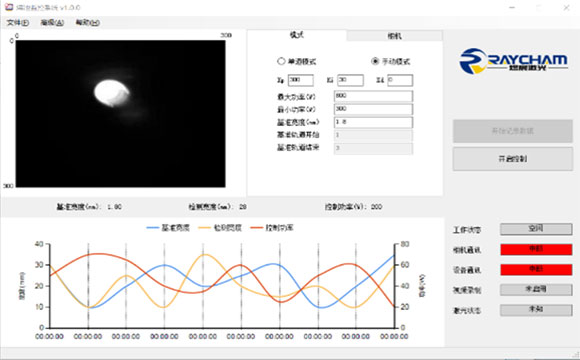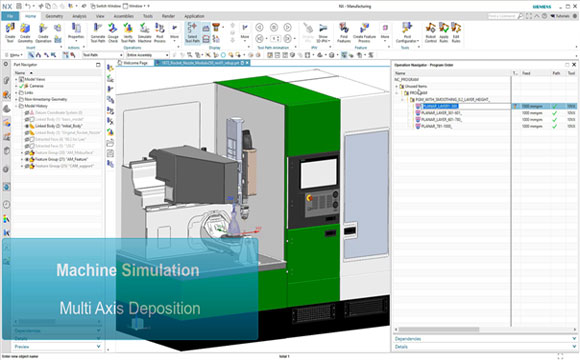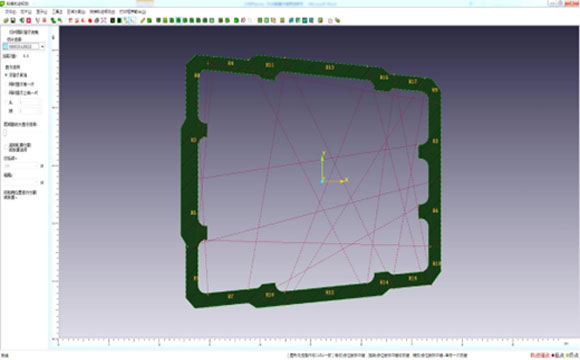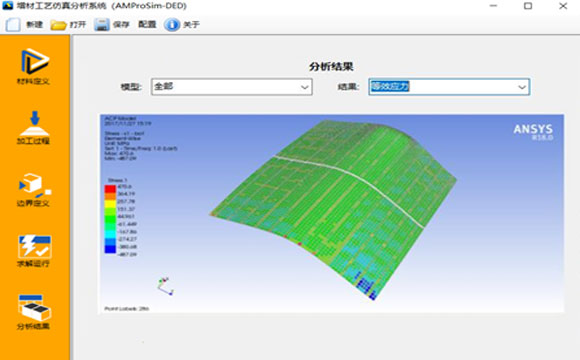Additive Manufacturing:
Automation, Digitization, Intelligence, Cloudification
The software team of Raycham focuses on key core technology research for metal additive manufacturing, including digital design, large-scale production, and intelligent control. This includes image feature recognition and classification, heterogeneous data analysis, and path dynamic planning. It has now formed a dedicated software system for additive manufacturing called RASIC, which consists of RC-ARGUS for equipment safety and health management, RC-AMProSim for additive manufacturing process simulation, RC-IPM for online monitoring, and RC-CAM for path planning. The software and additive manufacturing equipment have achieved efficient collaboration and have been successfully applied in industries such as aerospace and mold making for part manufacturing.
The software adopts machine vision and PID control methods to provide real-time monitoring of the meltpool morphology in laser directed energy deposition additive manufacturing. This helps to reduce instability factors during the metal 3D printing process, effectively improving deposition quality and efficiency. The software also synchronously records meltpool image data and real-time power, facilitating in-depth analysis and optimization of the forming process by process personnel.

This software is an integrated platform developed by Zhongke Yuchen based on the Multi Axis Deposition module in the Siemens NX platform. It provides both additive manufacturing path planning and subtractive processing path planning. It supports various structures of additive and subtractive manufacturing equipment, such as three-axis machines, five-axis machines with four-linkage or five-linkage, as well as post-processors for different models of domestic CNC systems like Siemens 828D, 840D, Huazhong Numerical Control, Guangzhou Numerical Control, and robot control systems. It can directly output the motion CNC program for equipment. The software platform includes a digital library of equipment models, consisting of "equipment structure + CNC system," which enables comprehensive virtual operation and usage of standard machine models for additive and subtractive manufacturing by Zhongke Yuchen. It optimizes part printing path planning strategies and checks for interference collisions during equipment motion. Furthermore, it allows for optimized design of non-standard additive and subtractive manufacturing equipment based on the geometric characteristics of the parts to be printed.

In the field of laser powder deposition and arc wire additive manufacturing and repair processes, mature printing process software is provided to meet the trajectory planning requirements for metal parts with different structural characteristics. The software's main functions include: • Flat slicing trajectory planning for conventional structural parts • Trajectory planning for rotating parts with arbitrary axis section shapes (or axis) • Surface slicing trajectory planning for special applications such as printing on curved base surfaces that have specific features (such as impeller blades, propeller blades, protrusions that grow on any curved surface, such as ribs and reinforcement frames) • Full 3D motion simulation of the printing process for CNC machine additive equipment (with dual-axis CNC rotary table) or KUKA robot additive equipment (with dual-axis positioning mechanism).

The RC-CAE software is a professional process simulation system based on the ANSYS software platform, developed specifically for the directed energy deposition (DED) process in metal additive manufacturing. The software takes into account the temperature-dependent nonlinear properties of materials and simulates the material deposition process based on the motion path information from the process file. It can accurately simulate the effects of part partitioning, printing paths, and the phase change of melting and cooling on the additive manufacturing process. It predicts temperature, stress, and deformation during the additive manufacturing process, optimizes process parameters, ensures print quality and efficiency, and avoids inefficient trial and error processes. The key features of the software include: • Scan path simulation: Convert control command information from the printing program into path data tables that can be read by the simulation. The data tables describe the coordinate positions, scanning speeds, laser states, and dwell times of the scan path to simulate the material stacking process. • Transient thermal analysis: Using the cell birth and death technique, the software sequentially activates the forming material based on the scanning path to simulate the transient heat transfer behavior during the additive manufacturing process. The laser power input serves as the heat source, and the boundary conditions account for convective heat transfer and radiation between the workpiece, substrate, and environment. It also considers the latent heat generated during phase change, accurately simulating the impact of repeated melting and solidification processes near the melt pool on the temperature field. • Stress analysis: Building upon the transient thermal analysis, the software performs deformation and stress analysis through thermal-stress coupling. It takes into account temperature-dependent nonlinear stress-strain relationships to simulate the nonlinear elastic-plastic behavior of the material during the printing process, accurately describing the stress-strain state.

The software adopts a cloud platform to manage the data of the additive manufacturing process. It provides unified health monitoring and maintenance for multiple equipment (including equipment utilization, energy consumption, type distribution, runtime ranking, environmental parameters, and status). It also offers maintenance reminders for multiple equipment, image collection and storage of printed layers, status display of equipment functional modules, real-time playback of equipment printing process, real-time management of equipment fault alarms, and statistical management of historical alarm data. It can achieve real-time monitoring of all equipment in the entire factory area for 24 hours.

The software has a high level of intelligence and provides real-time collection and visualization of equipment status parameters, as well as the ability to trace historical data of these parameters (with flexible data point configuration). It also includes the status display of equipment functional modules, real-time playback of equipment printing process, real-time management of equipment fault alarms, and statistical management of historical alarm data. It can achieve 24-hour real-time monitoring of individual equipment.
